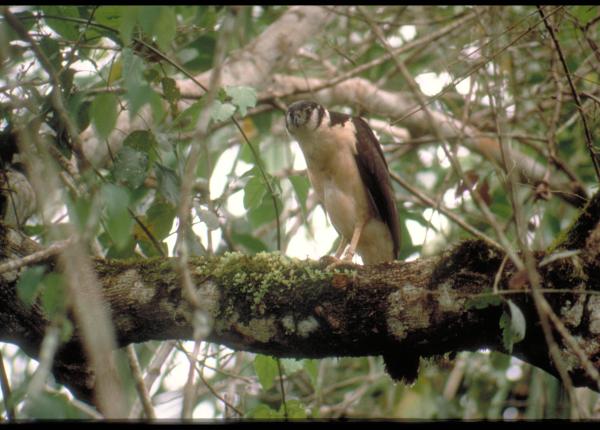Did You Know?
- The Collared Forest-falcon has three color morphs: dark, pale and tawny.
- In Ecuador and Brazil, researchers have documented Collared Forest-falcons competing with macaws for tree nest cavities.
How The Peregrine Fund is Helping
The Peregrine Fund spent nine years from 1988 to 1996 studying Neotropical birds of prey in the Peten region of Guatemala in an ambitious undertaking called the Maya Project. At that time, biologists located and studied several Collared Forest-falcon nests. This information helped contribute to the scientific world's knowledge of this species. This is important because the more we know about a species, the better we are able to help conserve it. The Peregrine Fund published the results of the Maya Project in a book called "Neotropical Birds of Prey, Biology and Ecology of a Forest Raptor Community."
Where They Live
Like the Bicolored Hawk or the Black Hawk-eagle, the Collared Forest-falcon is a neotropical species. It is found from southern Mexico through much of Central America and south to northern Argentina.
The Collared Forest-falcon lives in an array of different habitats throughout is range. It can be found from lowlands to middle elevations of 2,500 m or higher. It might spend its time perched in tangled thickets in intact or broken forest, in swamp forests, mangroves, late second-growth forest and scrub habitat. It is considered an "edge species" meaning it rarely is observed deep inside a large forested area.
What They Do
The Collared Forest-falcon, like all the forest-ffalcons, is a spectacular-looking bird. It has long yellow legs, a long black and white tail, a creamy white underbelly and breast a dark head and back. True to its name, it has two dark bands on its neck that make it look like it is wearing a collar. It has large eyes.
Like the Harpy Eagle, the Collared Forest-falcon does not soar. It is often heard calling - a mournful sound - around dawn and after dusk. It can be otherwise hard to find in its forest and edge habitat. When not hunting it may rest lengthwise on a branch like a nightjar!
Why They Need our Help
The Collared Forest-falcon is relatively widespread throughout its range. It is categorized as a species of "Least Concern" which means conservationists aren't extremely worried about its population in the near future at least. However, its favorite nesting tree, the Spanish Cedar Tree, is a species often targeted by loggers and this could put the falcon at great risk in the future if it is unable to find adequate nesting sites. After all, if they cannot nest, they won't be able to have young and eventually that will cause their numbers to drop dramatically.
Individuals that are found near human inhabited areas might also be at risk because people might see them as threats to their domestic fowl - like chickens!
What They Eat
The Collared Forest-falcon has a varied diet. It feeds on large lizards, snakes, rodents, birds (up to the size of guans and ibises), and large insects. People have reported that it also preys on domestic chickens.
It hunts by ambush from a concealed perch, by flying from perch to perch, by running along large branches, or even running on the ground with amazing speed and agility. It hunts at dawn and dusk. It also may follow army ant swarms to capture invertebrates flushed by the ants.
Scientists believe these forest-falcons are attracted to the sounds made by excited birds, or by imitations of such sounds and may even deliberately emit high-pitched calls to attract birds which it will later attempt to catch.
Nests, Eggs, and Young
The Collared Forest-falcon makes its nests in cavities - including in natural tree cavities, holes in cliffs, in caves, and even sometimes in abandoned buildings.
When the time is right, the female will lay between 1 and three eggs. Her eggs are white, and usually spotted with chocolate-colored spots. After the eggs are laid, the female does most, if not all, of the incubating. This means she must sit on the eggs to keep them safe and warm for at least 46 days. At this time, it is the male's job to feed himself and her, so he is busy chasing after prey several times a day.
Once the eggs hatch, the nestlings will grow quickly and need plenty to eat. At this time, the female lends the male a hand and helps bring prey to their young. Though nestlings grow quickly, they will remain in the nest for up to 50 days, before fledging, or flying for the first time.
Collared Forest-falcon and the World Center for Birds of Prey
The World Center for Birds of Prey offers fun ways to learn about birds of prey. The visitor center offers interactive displays, tours, interesting videos and a children's room with activities from coloring sheets to quizzes to costumes and a touch table for the curious mind. We also have many different birds of prey on display year-round. Knowledgeable staff and volunteers are on hand to answer any questions you may have about Collared Forest-falcon or any other bird of prey.
Resources:
Bierregaard, R. O., G. M. Kirwan, and P. F. D. Boesman (2020). Collared Forest-Falcon (Micrastur semitorquatus), version 1.0. In Birds of the World (J. del Hoyo, A. Elliott, J. Sargatal, D. A. Christie, and E. de Juana, Editors). Cornell Lab of Ornithology, Ithaca, NY, USA. https://doi.org/10.2173/bow.coffal1.01
Global Raptor Information Network. 2020. Species account: Collared Forest Falcon Micrastur semitorquatus. Downloaded from http://www.globalraptors.org on 4 Apr. 2020
Thorstrom, R. 2000. The food habits of sympatric forest-falcons during the breeding season in northeastern Guatemala. Journal of Raptor Research 34:196-202.
Thorstrom, R.. 2001. Nest-site characteristics and breeding density of two sympatric forest-falcons in Guatemala. Ornitologia Neotropical 12:337-343.
Thorstrom, R. 2007. Home ranges of Barred (Micrastur ruficollis) and Collared Forest-falcons during the breeding season in Tikal National Park,Guatemala. Ornitologica Neotropical 18:395-405.
Thorstrom, R.K. 2012. Collared Forest Falcon. Pp. 250-254 in D.F. Whitacre (ed.), Neotropical birds of prey: biology and ecology of a forest raptor community. Cornell University Press, Ithaca, NY.
Thorstrom, R., J.D. Ramos, and J.M. Castillo. 2000. Breeding biology and behavior of the Collared Forest-falcon (Micrastur semitorquatus) in Guatemala. Ornitologia Neotropical 11:1-12.
Thorstrom, R., C.L. Turley, F.G. Ramirez and B.A. Gilroy. 1990. Description of nests, eggs, and young of the Barred Forest-falcon (Micrastur ruficollis) and of the Collared Forest-falcon (M. semitorquatus). Condor 92:237-239.









